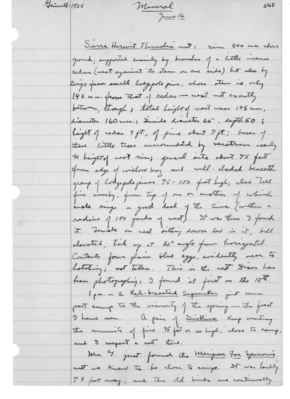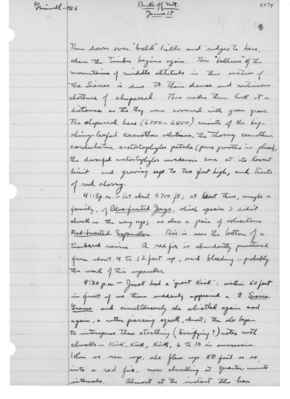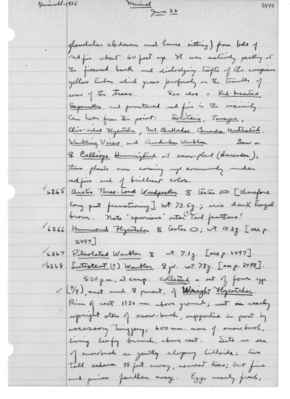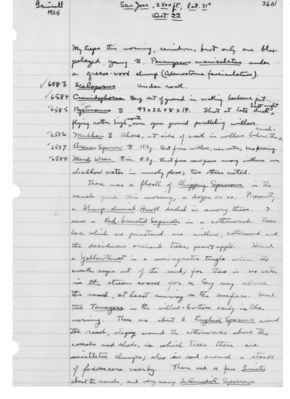Pages That Mention Red-breasted Sapsucker
1925: Joseph Grinnell's field notes
S2 Page 12
Collector: Grinnell - 1925 Location: Lassen Section (Mineral) Date: June 16, 1925 Page Number: 2468
Sierra Hermit Thrushes nest: rim 800 mm above ground; supported mainly by branches of a little incense cedar (nest against its stem on one side) but also by twigs from small lodgepole pine, whose stem is only 145 mm. from that of cedar - nest not exactly between, though; total height of nest was 145 mm., diameter 160 mm.; divide diameter 65, depth 50; height of cedar 4 ft., of pine about 7 ft.; bases of these little trees surrounded by veratrum nearly to height of nest rim; general site about 75 fee from edge of willow bog and well-shaded beneath group of lodgepole pines 75-100 feet high; also tall firs nearby, from tip of one or another of which male sings a good deal of the time (within a radius of 100 yards of nest). It was thus I found it. Female on nest sitting down low in it, bill elevated, tail up at 80° angle from horizontal. Contents four plain blue eggs, evidently near to hatching; not taken. This is the nest Dixon has been photographing; I found it first on the 13th. 1 p.m. - a Red-breasted Sapsucker just came past camp to the vicinity of the spring - the first I have seen. A pair of Siskins keep visiting the summit of firs 75 feet or so high, close to camp, and I suspect a nest there. Mrs. G just found the Mariposa Fox Sparrow's nest we knew to be close to camp. It was hardly 75 feet away, and the old birds are continually
S2 Page 19
Collector: Grinnell - 1925 Location: Lassen Section (Brokeoff Mt.) Date: June 17, 1925 Page Number: 2474
Then down over "bald" hills and ridges to here, where the Timber begins again. This "baldness" of the mountains of middle altitude in this section of the Sierras is due to their dense and continuous clothure of chaparral. This makes them look at a distance as tho they were covered with green grass. The chaparral here (6000-6500) consists of the big shiny-leafed ceanothus velutinus, the thorny ceanothus condulatus, arctostaphylos patula (pure growths in places), the dwarfed arctostaphylos nevadensis here at its lowest limit and growing up to two feet high, and tracts of red cherry. 4:15 p.m. - At about 6700 ft.; at least there, maybe a family, of Blue-fronted Jays, which species I didn't check on the way up; as also a pair of solicitous Red-breasted Sapsuckers. This is near the bottom of a timbered ravine. A red fir is abundantly punctured from about 4 to 12 feet up, and bleeding - probably the work of this sapsucker. 4:30 p.m. - Just had a "great kick": within 50 feet in front of us there suddenly appeared a female Sierra Grouse and simultaneously she whistled again and again, a rather piercing squall, almost; then she began to intersperse these startling (terrifying?) notes with clucks - kirk, kirk, kirk, 6 to 10 in succession. When we ran up, she flew up 80 feet or so into a red fir, now clucking at quarter-minute intervals. Almost at the instant the hen
S2 Page 45
Collector: Grinnell - 1925 Location: Mineral Date: June 26 Page Number: 2499
glandular abdomen and hence sitting) from bole of red fir about 60 feet up. It was actively pecking at the fissured bark and dislodging tufts of the conspicuous yellow lichen which grows profusely on the trunks of some of the trees. Saw also a Red-breasted Sapsucker, and punctured red fir in the vicinity. Can hear from this point: Solitaire, Tanager, Olive-sided Flycatcher, Mt. Chickadee, Canada Nuthatch, Warbling Vireo, and Audubon Warbler. Saw a [female symbol] Calliope Hummingbird at snow-plant (Sarcodes); these plants now coming up commonly under red firs and of brilliant colors.
6265 Arctic Three-toed Woodpecker [male symbol] testes [illustration] [therefore long past functioning] wt. 73.5g.; iris dark hazel brown. Note "spurious" outer ^(?) tail feathers!
6266 Hammond Flycatcher [male symbol] testes [illustration]; wt. 10.2g. [see p. 2497].
6267 Pileolated Warbler [male symbol] wt. 7.1g. [see p. 2497].
6268 Lutescent (?) Warbler [female symbol] jv. wt. 7.8g. [see p. 2498].
5:00p.m., at camp: collected a set of four eggs 4/4, nest and female parent, of Wright Flycatcher. Rim of nest 1130mm above ground; nest on nearly upright stem of snow-bush, supported in part by accessory twiggery; 600 mm. more of snow bush, living leafy branch, above nest. Site in sea of snowbush on gently sloping hillside; two tall cedars 75 feet away, nearest trees; but firs and pines farther away. Eggs nearly fresh;
S3 Page 36
Collector: Grinnell - 1925 Location: La Grulla, 7200 ft. Date: Oct. 9 Page Number: 2579
Red-breasted Sapsucker again, but failed to sight him; he evidently visits a series of punctured trees in a sort of regular or irregular circuit. Tonight I saw a Prairie Falcon in flight; my attention was attracted to it by hearing the startled shreek (sic) of a ground squirrel These squirrels get into my steel traps every day; they must smell the meat bait, or else cover a great deal of ground in promiscuous foraging each day. Merriam Chipmunks are as numerous as chipmunks any place I have ever been; they, too, cover all sorts of ground pretty thoroly. Almost every sort of bird and mammal now a days, visits the cascara bushes, which are fruiting plentifully. There are no acorns, and few or no fruits of the manzanita and buckthorn. The pine cone crop is fair. Take away the pines and the cascaras, and the birds and mammals would be faring poorly, indeed; doubtless a number of the species would promptly become extinct. Another year the oaks might be the dependence. I have seen much more mole sign, even far up in the hills, beyond any gopher workings, where the coarse granite gravel between the boulders looks most sterile. In such places the mole "ridges" are sinuous, caved-in grooves-- the animals leaving no hole, just moving along close to the surface, and
S3 Page 58
S3 Page 58
Collector: Grinnell - 1925 Location: San Jose, 2500 ft., lat. 31° Date: Oct. 22 Page Number: 2601
My traps this morning, rained on, brot only one blue pelaged, young (male sign), Peromyscus manipulatus under a grease-wood clump (Adenostoma fasciculatum).
6583 Sceloporus Under rock. 6584 Cnemidophorus Dug out of ground in making barbecue pit. 6585 Nyctinomus (male sign) 93 x 32 x 8 x 14. Shot at late last dusk last night flying rather high north over open ground paralleling willows. 6586 Mudhen (female sign) alone, at side of creek in willow bellow the ranch. 6587 Brewer Sparrow (male sign) 11.9g. Shot from willow, near water; was preening. 6588 Marsh Wren (male sign) im. 11.9g. Shot from sawgrass among willows near shallow water in marshy place; two others noted.
There was a flock of Chipping Sparrows in the ranch yard this morning, a dozen or so. Presently a Sharp-shinned Hawk dashed in among them. I saw a Red-breasted Sapsucker in a cottonwood. Trees here which are punctured one willow, cottonwood and the deciduous orchard trees, pear & apple. Heard a Yellowthroat in a semi-aquatic tangle where the creek seeps out of the sand; for there is no water in the stream course for a long way above the ranch, at least running on the surface. Heard two Tanagers in the willow-bottom early in the morning. There are about 6 English Sparrows around the ranch, staying around the cottonwoods above the corrals and sheds, in which trees there are mistletoe clumps; also in and around a stock of fodder corn nearby. There are a few Linnets about the ranch, and very many Intermediate Sparrows.




